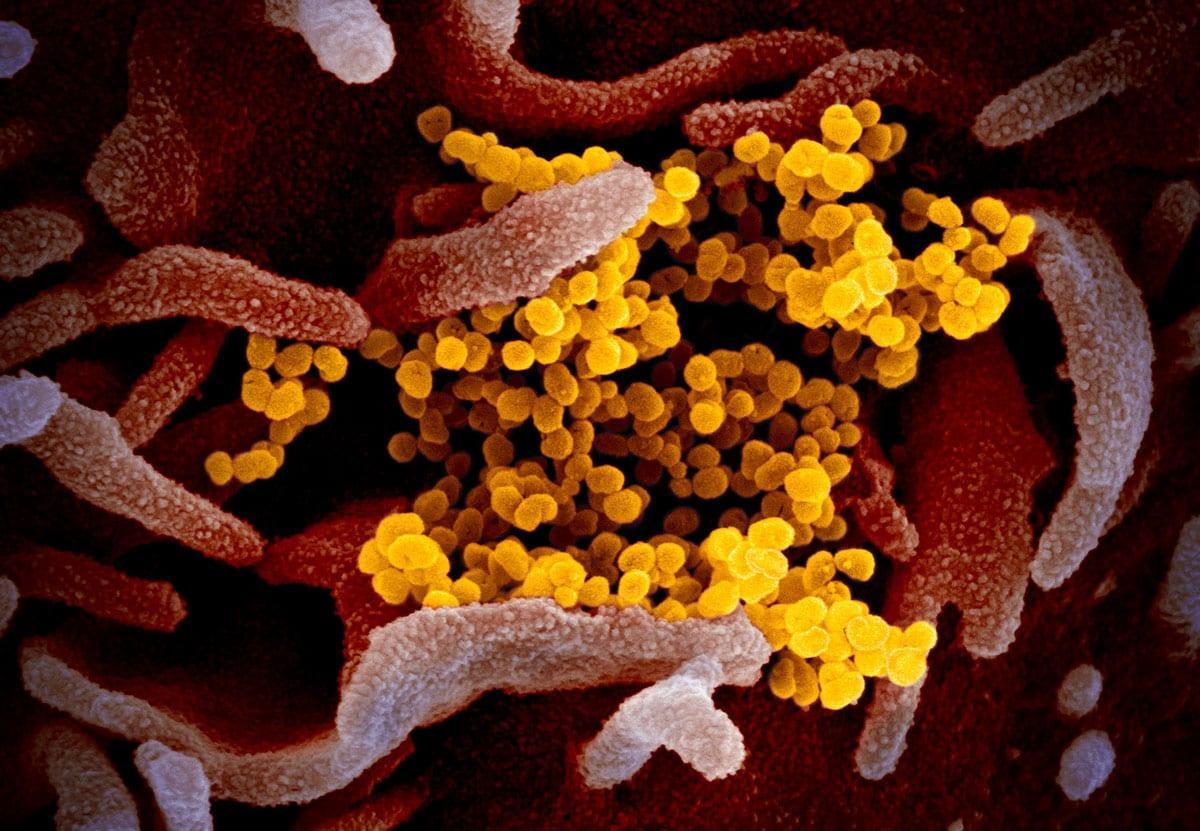
25 Mar “Viral Sentience” by Nicolas Holt
ISEA2020—like most gatherings, research opportunities, and events of all kinds—has been put on hold due to the novel coronavirus pandemic spreading throughout most of the globe. The circumstances most of us are currently living under haven’t been seen in a generation and it seems now, more than ever in recent memory, it’s helpful to try and make the best out of a bad situation.
In the spirit of this effort, this post attempts to think together ISEA2020’s theme of sentience in relation to the now disastrously relevant category of the viral. That is, this post hopes to briefly explore what, if any, points of contact exist between sentience— “the ability to feel or perceive,” to quote from ISEA’s call for papers—and the virus considered as an entity, though not necessarily today’s novel coronavirus specifically. Rather, virus here is taken in broad biological terms and defined by OED as “an infective agent that typically consists of a nucleic acid molecule in a protein coat, is too small to be seen by light microscopy, and is able to multiply only within the living cells of a host.” Of course, there are more digital variations on the term virus but those will be left aside for now, as will the geopolitical, economic, and social ramifications of the viral pandemic in which we’re currently living. These topics are potentially for another post. Here, the concern falls exclusively on the following questions: What can a virus and its mode of being tell us about sentience? Can a virus be considered sentient at all? Or, rather, what happens when the viral and the sentient are brought together? Furthermore, where do questions like this lead?
At the bottom of this post is the link for an article in Scientific American by Luis P. Villarreal titled “Are Viruses Alive?” It’s a short but informative read, and much less bogged down in microbiological terms than another interesting, somehow shorter though denser, article by the same title written by Nigel Brown and David Bhela in Microbiology Today’s issue “What is Life?”, also linked to below. Both articles think through the questions of whether or not viruses could be considered alive or not, living things or dead things, part of the evolution of life or accessory to its downfall. The scientific consensus within these articles is that a virus somehow occupies a position halfway between the living and the dead. On its own and outside a host, a virus, understood as genetic material folded in protein, doesn’t have the self-contained bio-machinery, like mitochondria, to reproduce and sustain itself as all cellular life does—and the more complex life that scales upward from cellular activity. In that way, a virus doesn’t have the self-organizational autonomy we’ve been accustomed to attribute to living things since the rise of second-order cybernetics and the popularization of the term “auto-poeisis.” However, a virus, once it has found its way into a host, effectively coopts a cell’s reproductive assemblages to create more of itself, hacking into the host’s genetic code as it were, spreading itself to other cells, and creating an infection—and in even more radical cases, causing genetic mutations typically thought to be the result of long histories of naturally selective evolution
There are two important things to note about how the virus works that lead into a discussion of sentience: the first, a virus basically senses when it’s in the proper cellular conditions to multiply; the second, a virus makes use of its immediate, sensed environment, discerning it from others more hostile, to successfully exist and propagate. Something tricky happens at this moment that won’t surely be resolved here but might be thought through more interestingly once ISEA2020 finally commences in October: What is the relation between being alive and being sentient? Viruses occupy a strange and fuzzy kind of undead region between life and death (maybe that’s why they’re at the center so many zombie movies and TV shows). Nonetheless, in certain formulations viruses could be said to, though perhaps minimally, sense, perceive, and make use of their surroundings in a way that most lifeforms—whose liveliness and sentience could hardly be questioned, like us, for instance—certainly do. It’s simply the case that, for viruses, their environmental relations and persistence culminates most fully in (literally inside) a host—where the host acts as the cellular version of the more macro environments from which larger flora and fauna individuate. That is, viruses obtain life in, and with the support of, living environments. David Bhela, of the second article below, sees this as something quite common, after all “no organism is entirely self-supporting… life is absolutely interdependent.” This a basic rule of ecology, one of the most popular discourses in critical thought today. In a potentially perverse way, then, maybe viruses are the most ecological of all beings. The very condition of possibility for viral life is met only through its deep associations with other lifeforms and living surfaces. Many ecological thinkers today would certainly say the same of us.
At this point it’s important to ask: What’s gained by opening up sense, feeling, and sentience to entities with an apparent (non)complexity below that of even the lowliest of unicellular organisms? Viruses, biologically speaking, cannot count as cells because of their lack of certain metabolic capacities and reproductive autonomies—though some, like the Mimivirus discovered by Didier Raoult in 2004, have been measured as larger than some amoebas, indicative of a kind of self-contained, structural coherence. However, major advancements across the sciences and humanities have recently been made by seeking sense, as well as cognition, within some of the most basic of lifeforms imaginable. Cognitive biology is one such example. According to N. Katherine Hayles, quoting Pamela Lyon and Jonathan Opie, “cognitive biology offers a framework consistent with empirical results: ‘Mounting evidence suggests that even bacteria grapple with problems long familiar to cognitive scientists, including: integrating information from multiple sensory channels to marshal an effective response to fluctuating conditions; making decisions under conditions of uncertainty; communicating with conspecifics and others (honestly and deceptively); and coordinating collective behavior to increase the chances of survival.” Hayles’ references cognitive biology in her Unthought: The Power of the Cognitive Nonconscious as a potential resource for understanding modes of cognition that, while underpinning rational, primary (human) conscious, are also integral to bacterial life, plants, animals, and even some complex technical systems—all components of what she calls the “planetary cognitive ecology.” Important to Hayles’ work is the link between sense, perception, and cognition; this is a constellation gaining ever more traction in the research programs of embodied cognition and theories of extended mind where thought, sense, and the sensed environment are irreducibly entwined. Life linked to, and wholly dependent upon, its continually sensed surround describes us just as much as it does a virus.
To ask, as ISEA2020’s does, “Why Sentience?” might also be to ask “Where Sentience?” That is, as the question of sentience becomes ever more important to contemporary thought and artistic production, it becomes equally more important to search out where sentience might reside, in what entities, and in what ways does it arise within them. The consensus on whether or not viruses constitute life at all, let alone could be considered sentient beings, has yet to be reached satisfactorily—scientifically or otherwise. Indeed, viruses possess a disconcerting ability to straddle life and nonlife, and in so doing reveal the indeterminacies between such categories on even sub-molecular levels. This is, to be sure, conceptually exciting. However, as a virus approaches a lively sentience—as it feels its way through its membrane-bound environments and replicates—it threatens the very sentience of its host. The stakes of such a process—as we are becoming increasingly, and frighteningly aware—are higher than they’ve been in a generation. Sometimes sentiences conflict, and ISEA2020 seems like an appropriate place to pursue this further. Until then, take care and stay well.
Texts referenced:
Luis P. Villarreal, “Are Viruses Alive?” The Scientific American, https://www.scientificamerican.com/article/are-viruses-alive-2004/
Nigel Brown and David Bhela, “Are Viruses Alive?” Microbiology Today, issue: “What is Life?” https://microbiologysociety.org/publication/past-issues/what-is-life/article/are-viruses-alive-what-is-life.html
Pamela C Lyon and Jonathan P. Opie, “Prolegomena for a Cognitive Biology,” Presented at the Proceedings of the 2007 Meeting of International Society for the History, Philosophy and Social Studies of Biology, University of Exeter. Abstract at https://digital.library.adelaide.edu.au/dspace/handle/2440/46578
N. Katherine Hayles, Unthought: The Power of the Cognitive Nonconscious (Chicago: The University of Chicago Press, 2017).
Photo credit: NIAID-RML



